The Glorious Vegetables of Italy by Domenica Marchetti – A Book Review
Carrot-Ricotta Ravioli with Herbed Butter
Green is the new black, so the food writers say. Vegetables are the answer to feeding a hungry planet, so the scientists say. However, this is not news to Italians. Their country’s rich soil produces an abundance of vegetables, each variety in astonishing array. Through the ages, from Apicius of ancient Rome, to Bartolomeo Scappi and Giacomo Castelveltri of the 16th and 17th centuries, right up to Pellegrino Artusi, Italian food writers have had a way with vegetables. With The Glorious Vegetables of Italy, food writer and cookbook author Domenica Marchetti has produced a treasure for our times and beyond. This book is the second in my Suggestions for Christmas Giving, but perhaps you had better not wait until Christmas. After all, the groaning board that is the Thanksgiving feast is replete with vegetables.
In this third volume of Ms. Marchetti’s Glorious series, she demonstrates the versatility and brilliance of classic Italian vegetable cookery, reinterpreted for the contemporary palate. It’s all here, opening with a section on vegetable identification, uses and seasonality, including a beautifully realized photographic gallery. There are basics on equipment and herbs, pasta dough and sauces. Course by course, this book will realign the senses of anyone who thinks of vegetables only as side dishes.
Among the tantalizing selection of appetizers is Crostini with Taleggio and Caramelized Onions. Here, one of Nature’s most humble vegetables, the bulb onion is transformed to candy-like sweetness by long cooking over low heat. Taleggio, Italy’s answer to Brie, is spread over crostini, crowned with the golden onions, and passed briefly under the broiler creating a sweet, absolutely mouth watering appetizer. Sweet-and-Sour Eggplant Salad is tender and flavorful. A spoonful spread on crostini and topped with a bit of smooth sheep’s milk Cacio di Roma, makes a complex, multi-layered appetizer. With this chapter, a host will find it a simple matter to put together a selection of small bites for holiday cocktail parties, wine tastings or as starters for the season’s big feasts. Pasta, risotto, gnocchi, and polenta, are served with seasonal vegetables, utterly tempting and within reach of the skills of any home cook.
A broad selection of pizza, calzoni and panini, all with vegetable toppings and fillings, will delight family and friends. Ms. Marchetti’s basic pizza dough is simple to make, virtually foolproof. Today’s food commentators have remarked that American pizza, so often overwhelmed by dense, overdone toppings, has become merely a conveyance apparatus for cheese. There is none of that here. The flavors are balanced, never overdone and always complementary. Pizza Bianca with Roasted Fennel is a beautiful marriage of sweet fennel, smooth, creamy ricotta and melted mozzarella, punctuated by salty bursts of pancetta.
Long cooked, garlicky kale is featured in the Tuscan Kale Frittata. The cruciferous vegetable is combined with eggs and salty, bold Pecorino cheese, cooked briefly on the stovetop, finished under the broiler, and brought to the table bubbling and lightly browned. With a green salad, a bit of crusty bread and a glass of wine, it makes a light yet satisfying supper.
There are soul satisfying soups aplenty. Some are classics revisited, like Tuscany’s Ribollita, and others are new, but all are perfect for chilly winter nights, packed with flavor and nutrients, and presented in the author’s easygoing, confidence inducing style.
Once you try the Roasted Mushrooms, you will never saute this vegetable again. The mushrooms are tossed with garlic-infused oil, chopped parsley, and salt and pepper, their earthy richness and woodsy flavor enhanced as they roast to a dark mahogany. This simple preparation is much greater than the sum of its parts, yet another example of the author’s contemporary sensibility.
Pasta al Forno with Roasted Vegetables is a mélange of pasta, cheeses, zucchini, eggplant and roasted mushrooms. It is a delight for the vegetarians in the house, and with the (optional) addition of sausage, makes a hearty one-dish dinner. The recipe yields a very generous 9×13 pan, enough to feed the whole family, and it is wonderful the second day.
Ms. Marchetti’s Potato and Mushroom Gattō, the classic Neapolitan potato cake, would make a sublime accompaniment to a holiday ham. Think of it as mashed potatoes reinvented. Potatoes are boiled, then put through a ricer and mixed with cream, parsley, Parmigiano, salt and pepper. They are layered into a springform pan with roasted mushrooms, mozzarella and scamorza cheeses, topped with breadcrumbs and a bit of butter and then baked.
Liberated from its ten-inch springform pan and brought to the table, this Gattō is a glory to behold, worthy of any holiday feast. Preparing the cheeses and roasting the mushrooms can be done up to 5 days ahead, making the assembly a snap.
If you think vegetables are not for desserts and snacks, think again. Pumpkin Gelato is perfumed with vanilla and spices, sweetened with dark chestnut honey and enriched with a touch of Punch Abruzzo. It will have you reconsidering Pumpkin Pie this Thanksgiving. Winter Squash Panna Cotta, its base of cream and mascarpone cheese infused with vanilla, cinnamon and nutmeg, is my new favorite take on this Italian classic.
Carrot Polenta Cake with Marsala, an unassuming little 8-inch delight, is flavorful and pleasingly moist.
Shredded carrots lend sweetness and texture, and finely ground polenta gives a bit of crunch and delicate corn flavor. I used a Ligurian extra virgin olive oil made by Vittorio Cassini. The buttery, delicate oil married beautifully with the orange and lemon zest and Marsala wine. This simple cake, devoid of frosting, literally disappeared from my kitchen. I had to ask Bart where it was. I thought it was the perfect afternoon snack… it turns out it was also good in the late evening and early morning.
The Carrot-Ricotta Ravioli are simply delicious, and the recipe is here for you to try. These half-moon shaped cushions are filled with a stunning golden-orange mixture of sweet roasted carrots and ricotta cheese.
Tossed in herbed butter and topped with a bit of Parmigiano, they are some of the best ravioli I have ever tasted, a truly unique primo. The recipe produces a dough that is at once supple and tender, extremely easy to work with, and ideal for making stuffed pasta.
Together the design team has created a feast for the eyes. The photography by Sang An is enticing and genuine, and the food styling by George Dolese, never intrusive, shows the food off to best effect.
Ingredients are listed by volume measurement and weight (both ounces and grams), and Ms. Marchetti’s explicit directions make following the recipes easy for any cook, whether seasoned or newcomer. The field of Italian cookbooks is a crowded one, but The Glorious Vegetables of Italy deserves a place on any serious cook’s bookshelf. Here vegetables are cooked the Italian way, until they are almost meltingly soft and sweet, their natural sugars and flavors enhanced by patient cooking on the stove top or in the oven. Any mother who can’t get her kids to eat vegetables has simply not spent enough time at Domenica’s table.
makes about 50 ravioli; 4 to 6 servings
I enjoy playing around with traditional Italian recipes—while staying true to the spirit of tradition, of course! This is a riff on classic spinach and cheese ravioli, with pureed carrot filling in (literally) for spinach. The resulting ravioli are beautiful—tender half-moon pillows with a bright orange-gold interior. They are sweet and delicate and need no further adornment than the herbed butter sauce that accompanies them in this recipe. Making homemade ravioli is a project for sure, but I would never call it a chore. Watching the ravioli take shape and multiply as you cut them out is a rewarding experience though the reward of eating them is even better.
Filling
3 large carrots (¾ lb/340 g), peeled and cut into 1-in/2.5-cm chunks
1 tbsp extra virgin olive oil
Sea salt
Freshly ground black pepper
2 tsp unsalted butter
1 tbsp minced shallot
1 tbsp heavy cream
5 oz/140 g fresh sheep’s milk or well drained cow’s milk ricotta cheese
6 tbsp/45 g freshly grated Parmigiano-Reggiano cheese
Pinch of freshly grated nutmeg
1 large egg yolk
semolina flour for dusting the work surface
1 batch fresh egg pasta
Herbed Butter
½ cup/115 g unsalted butter
2 tbsp mixed minced fresh herbs, such as parsley, sage, and marjoram
Fine sea salt
¼ cup /30 g freshly grated Parmigiano-Reggiano cheese
Heat the oven to 400°F/200°C/gas 6.
To make the filling: In a baking dish, toss the carrots with the olive oil and season with salt and pepper. Cover with foil and bake for about 30 minutes, until tender and lightly browned. Let cool slightly.
In a small skillet over medium heat, melt the 2 tsp butter. Add the shallot and cook until softened, about 3 minutes. Remove from the heat and let cool slightly.
In a food processor, combine the carrots, shallot, and cream and purée until smooth. Transfer the purée to a medium bowl. Stir in the ricotta, Parmigiano, and nutmeg and season with salt and pepper. Stir in the egg yolk until thoroughly combined. Cover and refrigerate until needed.
Cover a large work surface, such as a kitchen table with a clean tablecloth and sprinkle the cloth with a light coating of semolina flour. This is where you will put the ravioli once you have made them. Sprinkle a separate work surface with a light coating of semolina flour. This is where you will shape your ravioli. Have on hand a fluted pastry wheel for cutting out the ravioli, a glass of water for wetting your fingers, and a fork for sealing the ravioli.
Cut the ball of pasta dough into four equal pieces and rewrap three pieces. Stretch out the first piece into a long, thin strip about 28 in/71 cm long, 5 in/12 cm wide, and 1/16 in/2 mm thick. Carefully lay the dough strip out on the semolina-dusted work surface. Mound about 1½ tsp of the filling at 2-in/5-cm intervals along the length of the center of the strip. Dip a finger in the water and moisten along the bottom edge of the strip and the area around each mound of filling. Carefully fold the strip over lengthwise, gently nudging the mounds as you go so that the dough completely covers the mounds when the top and bottom edges meet. With your fingers, press around the mounds to separate and seal them. Use the pastry cutter to cut a half-circle around each mound to make individual half-moon-shaped ravioli (the straight side of the half-moon will be the folded side of the dough strip).
Once you have finished cutting the ravioli, gather up the dough scraps, press them into a ball, and put them in a plastic bag. Using the fork, press along the open edge of each raviolo to seal it securely. Transfer the ravioli to the semolina-dusted tablecloth. Continue to stretch out, fill, and shape the remaining dough pieces, collecting the scraps as you go. Reroll the scraps once to form additional ravioli. You should end up with 50 to 60 ravioli.
To make the butter: Bring a large pot of water to a boil over high heat and salt generously. While the water is heating, melt the butter in a small skillet placed over medium-low heat. When the butter begins to sizzle, stir in the herbs and a pinch or two of salt and cook, stirring, for 2 minutes, or until the butter has taken on the flavor of the herbs. Turn off the heat and cover to keep warm.
When the water is boiling, carefully drop the ravioli into the pot—you may need to cook them in two batches to avoid crowding. Cover the pot until the water returns to a boil and then uncover and cook the ravioli for 3 to 5 minutes, until they are just tender. Gently stir the water once or twice to make sure the ravioli do not stick together.
Spoon a little of the herbed butter sauce into the bottom of a warmed serving bowl. Using a skimmer or a large slotted spoon transfer the cooked ravioli to the bowl. Take care to let the excess water drain off the ravioli before you place them in the bowl. (If you have cooked the ravioli in batches, top the first batch with a little sauce and cover to keep them warm.) Once all the ravioli have been cooked and transferred to the serving bowl, drizzle the remaining herbed butter sauce over them and sprinkle Parmigiano cheese on top. Serve immediately.
COOK’S NOTE: The ravioli may be prepared over 2 days. Mix the filling on the first day and store it in the refrigerator overnight, then make the dough and assemble the ravioli the next day. The uncooked ravioli may be frozen for up to 1 month: Freeze on a large baking sheet in a single layer until firm, then transfer the ravioli to ziplock plastic bags or a container with a tight-fitting lid and return to the freezer.
makes about 1 lb/455 g
The key to making good fresh pasta is to relax. It’s an intuitive process, and the more you touch and handle the dough, the more familiar you will become with what it should feel like—how firm and smooth it should be. You can mix the dough the old-fashioned way on the countertop, or in the food processor. I often use the food processor to save time; it’s quick and works beautifully, but if using, just remember to start with the smaller amount of flour listed in the recipe. If the dough is sticky, you can always work in more flour as you knead.
2 to 2¼ cups/255 to 285 g Italian “00” flour or unbleached all-purpose flour
1 tbsp semolina flour, plus more for dusting the work surface and dough
½ tsp fine sea salt
Pinch of freshly grated nutmeg
3 extra-large eggs
1 to 2 tbsp extra-virgin olive oil
To mix the dough by hand: Combine the 2 cups/255 g “00” flour, semolina flour, salt, and nutmeg on a clean, smooth work surface. Form a mound and create a well in the center. Carefully break the eggs into the well. Use a fork to break the yolks and begin mixing the eggs. Drizzle in 1 tbsp of olive oil and work it in as you gently beat the eggs. Slowly begin to incorporate the inner wall of flour as you whisk. When the mixture has thickened, begin using your fingers to incorporate more “00” flour. Continue to mix until a rough dough has formed— you may not need all of the flour. Scrape any excess flour off to the side of your work surface. Sprinkle the work surface lightly with semolina flour and press the dough together to form a rough ball.
To mix the dough in the food processor: Put 2 cups/255 g of the “00” flour, semolina flour, salt and nutmeg into the work bowl of a food processor and pulse briefly to combine. Break the eggs into the work bowl and drizzle in 1 tbsp of the olive oil. Process the mixture until it forms crumbs that look like small curds. Pinch together a bit of the mixture and roll it around. It should form a soft ball. If it seems dry, drizzle in the remaining 1 tbsp olive oil and pulse briefly. If it seems too wet and sticky, add more “00” flour, 1 tbsp at a time, and pulse briefly. Turn the mixture out onto a clean work surface sprinkled lightly with semolina flour and press it together with your hands to form a rough ball.
To knead the dough: Using the palm of your hand, push the dough gently but firmly away from you, and then fold it over toward you. Rotate the dough a quarter turn, and repeat the pushing and folding motion. Continue kneading for several minutes until the dough is smooth and silky. Form it into a ball and wrap it tightly in plastic wrap. Let the dough rest at room temperature for 30 minutes.
To stretch the dough: Set up your pasta machine with the rollers on the widest setting (#1 on my standard Marcato Atlas hand-crank machine). Scatter a little semolina flour on the work surface around the machine and have more on hand for sprinkling on the dough.
Cut the dough into four equal pieces and rewrap three pieces. Knead the remaining piece briefly. Then, using a rolling pin or patting it with the heel of your hand, form the dough into an oval 3 to 4 in/7.5 to 10 cm long and about 3 in/7.5 cm wide. Feed the dough through the rollers of the pasta machine, and then lay the strip on the work surface. Fold the dough into thirds as you would a business letter, sprinkle with a little semolina flour. and pass it through the rollers again.
Repeat the folding and rolling process a few more times, until the strip of dough is smooth. Move the roller to the next narrower notch and feed the strip through twice, sprinkling it with semolina, if necessary, to keep it from sticking. Continue to pass the dough through the rollers twice on each setting, until it is the desired thickness. Lay the sheet of dough out on a semolina-dusted surface and cover it lightly with plastic wrap while you stretch the remaining three pieces.
To make ravioli: Stretch the dough to about 1/16in/2 mm thick—no thicker— on either the last or second-to-last notch on a standard pasta machine. You should be able to see the shadow of your hand through the dough. Fill and cut the ravioli according to the individual recipe.
To cut fettucine: Stretch the dough to about 1/16 in/2 mm thick or slightly thicker. Use the wide cutters on the pasta machine to cut the sheets into fettuccine. Sprinkle them liberally with semolina flour to keep them from sticking and wrap them gently around your hand to form nests. Set the nests on a semolina-dusted, rimmed baking sheet
To cut maccheroni alla chitarra: Stretch the dough to about 1/8 in/ 3 mm thick. Use the narrow cutters on the pasta machine to cut the sheets into chitarra noodles. Sprinkle them liberally with semolina flour to keep them from sticking and wrap them gently around your hand to form nests. Set the nests on a semolina-dusted, rimmed baking sheet.
To cut lasagne noodles: Stretch the dough to about 1/16 in/2 mm thick— no thicker—on either the last or second-to-last notch on a standard pasta machine. You should be able to see the shadow of your hand through the dough. Use a fluted pastry wheel to cut the sheets into rectangles about 4 by 5 in/10 by 12 cm.
To store the pasta: If you don’t plan to cook the pasta immediately, I recommend storing it in the freezer. I find this to be more reliable than drying, which can result in cracked or broken noodles. To freeze freshly cut pasta, put the tray of noodles or ravioli in the freezer and freeze for 1 hour or until firm. Carefully transfer the noodle nests or ravioli to a large container with a tight-fitting lid or to ziplock freezer bags. Return the pasta to the freezer until cooking time. You can store uncooked cut pasta in the freezer for up to 1 month. To cook, simply remove the pasta from the freezer and plunge them into a pot of salted boiling water. Cook until al dente, drain, and sauce as you please.
Visit the author’s website at DomenicaCooks.
For more on The Glorious Vegetables of Italy visit Ciao Chow Linda.
The Glorious Vegetables of Italy
by Domenica Marchetti
Hardcover: 272 pages
Chronicle Books (August 20, 2013)
ISBN-10: 1452108862
ISBN-13: 978-1452108865
Recipes reprinted courtesy of the publisher.
Author’s photograph by Olga Berman
The Carrot Polenta Cake with Marsala is shown on a plate by Ceramica Cerasella, one of a series I received from the company.
Vittorio Cassini Extra Virgin Olive Oil is available from Olio2go.
Note: You can click on any picture to see a slide show!
I have no affiliation with any product, manufacturer, or site mentioned in this article.


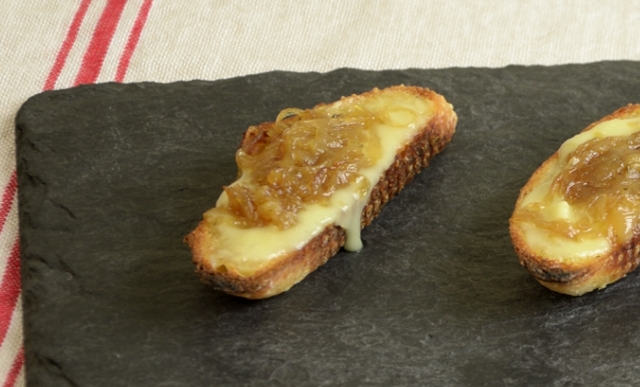





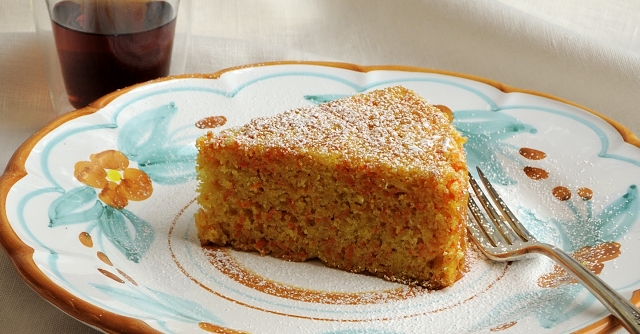
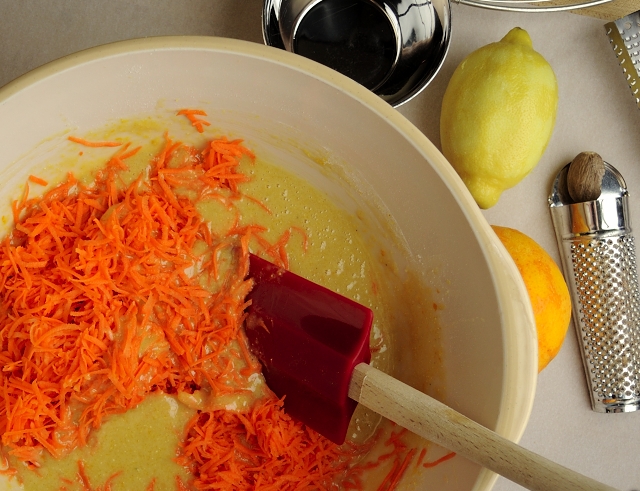

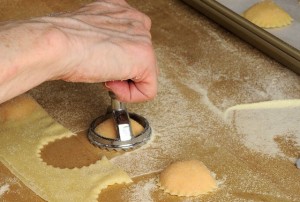
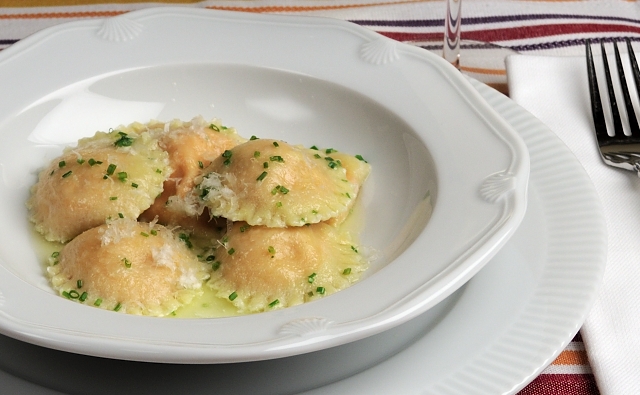

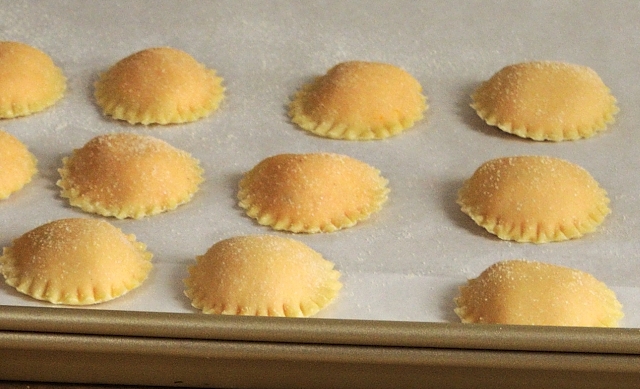
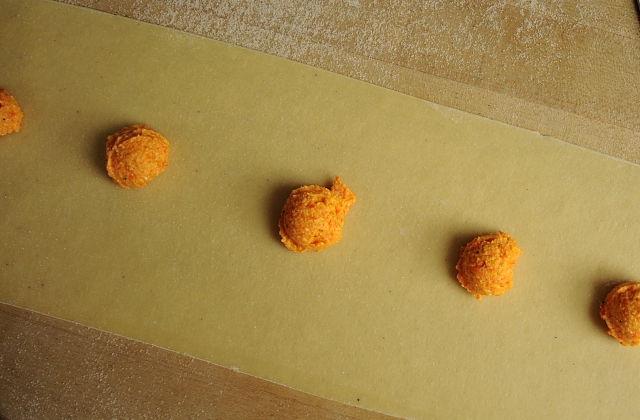


Saturday, November 9th 2013 at 5:58 am |
Thank you for sharing this new book, Adri. I have always liked Ms Marchetti’s recipes and didn’t realize she had a new book published. These recipes look absolutely delicious and make you want to get into the kitchen.
Saturday, November 9th 2013 at 6:24 am |
Ciao Jovina,
You will love this one. Page after page, it is quite an inspiration. Thanks for stopping by!
Saturday, November 9th 2013 at 7:05 am |
Oh wow… this all looks fantastic! I love the simplicity of cooking with vegetables. The are so versatile! I’m in love with those mushrooms and that carrot polenta cake has me swooning… xx
Saturday, November 9th 2013 at 7:21 am |
Hi Emilie,
Yes, the mushrooms are, not to sound trite, a revelation. Put those babies in the oven once, and you will ditch the fry pan forever. The cake- well, what can I say? I did make it a second time, since Bart robbed me of the opportunity to check on its keeping qualities. The second day it was even better than the first, the flavors having had a chance to marry. But the third day really surprised me; each flavor, in particular the orange and Marsala, had come forward a bit, but in a completely wonderful way. Plus the moistness kept it as delectable as on Day 1. It is, as they say, a “keeper.”
Saturday, November 9th 2013 at 9:18 am |
Wow! You really went to town cooking up a storm-fabulous job! I love this book, as well as Domencia’s others and have many pages of Glorious Vegetables bookmarked….you’ve inspired me to get moving!
Saturday, November 9th 2013 at 9:26 am |
Ciao Laney,
Yup, get to it. This one does not disappoint, and I would love to hear what you make from the book!
Saturday, November 9th 2013 at 9:32 am |
Well, now I know what to buy myself for Christmas! Your review has my mouth watering, especially the ravioli. Roasted carrot and Parmigiano… a match made in heaven.
Saturday, November 9th 2013 at 9:36 am |
Hi Lynne,
That’s high praise! I think you will love this one – wait until you see the Cream of Cauliflower Soup with Pancetta Croutons…
Saturday, November 9th 2013 at 9:53 am |
Adri – I am in love with this cookbook. There’s not a clunker recipe anywhere in it. You have been cooking up a storm from it, to judge from this wonderful post. I’ve made several things from it already, but the next thing has got to be those ravioli. You make everything look gorgeous with those photos and wonderful text, but those ravioli – well, they’re just a cut above.
Saturday, November 9th 2013 at 4:50 pm |
Hi Linda,
I’m with you. I love this book. You will flip for the ravioli. One of the nicest features of it is that you can make the filling the day before, and then assemble the ravioli the day of. And can you stand it – Bart and I consumed all of it! I used chives, not due to any particularly inspired culinary wizardry, mind you, but rather due to poor planning… chives is what I had, so chives it was. We loved it. I can’t wait to hear what you think!
Saturday, November 9th 2013 at 2:03 pm |
Domenica’s latest book looks wonderful. Despite Italian food’s North American reputation for being all pasta, meat sauce and cheese, it’s really the vegetables that take center stage in so many authentic recipes. Your detailed instructions for pasta making are wonderful! I’ve booked marked this for frequent reference.
Saturday, November 9th 2013 at 4:56 pm |
Ciao Due!
I love hearing from you two. You are so right about the reputation of Italian food, and I think this book will go a long way to enlightening readers.
I am pleased to hear that you found the pasta instruction of use. It is all Domenica’s work, and it is my pleasure to feature her here. The only trouble I encountered with this review was stopping! I have made many dishes from the book, and as Linda before you mentioned, there is not a clunker recipe anywhere. Best wishes to you both for a warm and wonderful Thanksgiving! Alla prossima!
Saturday, November 9th 2013 at 9:27 pm |
What a wonderful looking book. I’m especially eying that carrot polenta cake. What a nice change of pace from the standard American carrot cake.
Sunday, November 10th 2013 at 6:33 am |
Hi Carolyn,
The book is will give you so many ideas, and the carrot cake is sure to please – just ask my husband!
Saturday, November 9th 2013 at 10:00 pm |
I love making (and eating) ravioli but I’ve never done it with carrots as the filling. I love it!
Sunday, November 10th 2013 at 6:34 am |
Hi Maureen,
Try the carrot filling. It is wonderful, and was completely new to me. The cream smooths it and the shallots give it just a touch of savory flavor. I keep thinking it will be fab for a Spring luncheon.
Sunday, November 10th 2013 at 9:33 am |
Adri, I am touched by your post. I know that wasn’t your intent in writing it, but I’m touched just the same. I love that you tried so many recipes. Nothing makes me happier than knowing that people are actually cooking from my books. Your photos are fantastic. I want to plant my face right in that gatto’. Thanks for helping to spread the word about my work. Un abbraccio.
Sunday, November 10th 2013 at 10:01 am |
Ciao Domenica,
Thank you! There are so many wonderful things between the covers of this book. It is a very different look at vegetable cookery, and it succeeds in showing the reader just how versatile vegetables are. Additionally you point up, in recipe after recipe, how to really “cook” them. I have a vivid recollection of a back and forth with the late Marcella Hazan on this topic. She had written that one should not need “a knife and fork” to eat vegetables, that their true goodness comes out of long cooking – enough already with this tender-crisp thing. I think she would have given this book a round of applause. It was my pleasure to cook from it and to write about it. ABC
Sunday, November 10th 2013 at 10:33 am |
I’ve made plenty of ravioli with sweet potatoes or squash, but never with carrots. Love the idea! It sounds incredible. Super recipe, great book review. Thanks.
Sunday, November 10th 2013 at 11:06 am |
Hi John,
I’m glad you enjoyed it, and I hope you try the carrot ravioli. They are fab!
Sunday, November 10th 2013 at 2:37 pm |
I love ravioli but have never tried a carrot version, but I have made a carrot-infused fettuccine once that was amazing. I know I’d love these – they look fantastic!
Sunday, November 10th 2013 at 9:25 pm |
Hi Amy,
Give it a try. It is wonderful!
Sunday, November 10th 2013 at 7:39 pm |
I’m making that Gatto for sure, it will be on my table real soon. What a beautiful review you did Adri and the photos are tempting me to make everything! The polenta cake will be after that! If I didn’t have to make 400 ravioli soon I would attempt those gorgeous carrot ones. I will assure you though that during my cooking adventures I will pour a cold glass of wine and munch on those Taleggio and caramelized onion crostini! Yum!
Sunday, November 10th 2013 at 9:26 pm |
Ciao Marie,
Thanks for the kind words. This book is just one great recipe after another. You’ll love it all.
Sunday, November 10th 2013 at 10:00 pm |
I’m adding this cookbook to my Christmas wish list, Adri. All of the recipes sound delicious– The potato gatto looks amazing as do the carrot ravioli! My mouth was watering looking at all your wonderful photos!
Monday, November 11th 2013 at 6:59 am |
Hi Pat,
You will love this book. Like Linda said – no clunkers!
Monday, November 11th 2013 at 3:06 am |
I think the key is that the cookbook is in hands of a super-talented cook like you!! You’ve almost convinced me to become a vegetarian. Fantastic photos as always. Baci, Trisha
Monday, November 11th 2013 at 7:02 am |
Hi Trisha,
Thank you for the compliment! Every recipe in this book is super-doable. Perhaps the most complicated is this ravioli, but even that, broken down into steps is no biggie, especislly if you have a few extra hands in the kitchen. Domenica has written very detailed instructions that are easy to follow. About the vegetarianism – this book really is a fantastic display of just how good and varied the veg table can be.
Monday, November 11th 2013 at 10:55 am |
Adri, you certainly outdid yourself – I would not even know what to comment on first – it all looks perfectly delicious to me – but then, you already know that I am totally partial to anything VEG. If I had to decide, I would go with the beautiful looking carrot ravioli, I love the color, the way they are prepared, their elegance. I am sure they must taste out of this world delicious!
As always, a fabulous book review – your dedication to good quality, delicious food never ceases to amaze me!
Monday, November 11th 2013 at 12:47 pm |
Hi Andres,
This book just amazed me. The trouble I encountered with this review was where to stop – no kidding. I am sure it would be a complete delight for you. The Carrot-Ricotta Ravioli are just delicious. I hope you try them. You will flip! And thank you, as always, for the kind and supportive words.
Monday, November 11th 2013 at 1:55 pm |
The book really is a marvelous addition to anyone’s cookbook library. And that goes for folks like me who own hundreds. I am dying to try roasted mushrooms—Domenica mentioned the method in a recent comment on my blog and the idea really intrigues me. Nice to hear you confirm that it is as good as it sounds.
Monday, November 11th 2013 at 2:55 pm |
Hi Frank,
I keep saying that I have enough cookbooks… this one made a liar out of me. I’m glad to hear you are enjoying it too. The Roasted Mushrooms really are excellent. I’ve tried them with mushrooms prepared in various ways – very thinly sliced, quartered and more thickly sliced – each way they are great. On their own, or as part of other recipes, like the Pasta al Forno with Roasted Vegetables or Gattō, I was just amazed. I look forward to hearing your comments on the recipe. Thanks for stopping by. Alla prossima!
Monday, November 11th 2013 at 3:29 pm |
Oh my goodness…everything sounds wonderful. I wouldn’t know which recipe I would want to try first.
Monday, November 11th 2013 at 5:15 pm |
Hi Karen!
Decisions, decisions, and this is not even the half of it. There’s the Garlicky Lentil Soup, Chocolate Zucchini Cake… savor the possibilities!
Tuesday, November 12th 2013 at 12:03 am |
A book I need to own! Everything looks delicious and those ravioli are just fantastic.
Cheers,
Rosa
Tuesday, November 12th 2013 at 6:53 am |
Hi Rosa,
Yes, this one belongs on your shelf. Enjoy!
Tuesday, November 12th 2013 at 6:42 am |
The cookbook looks outstanding and so many fabulous photos. I love the idea of roasted mushrooms!
Tuesday, November 12th 2013 at 7:00 am |
Greetings!
Outstanding is definitely the word for this one. Those mushrooms were quite a surprise to me. Once I read the recipe, I just had to try them. I hope you make them, and thanks for stopping by!
Wednesday, November 13th 2013 at 7:03 am |
I love this book and just made the potato gatto and it was fabulous! I can’t wait to cook my way though the rest of the book.
Wednesday, November 13th 2013 at 7:32 am |
Hi Janie,
Oh, I am SO pleased to hear you have this book and very glad you enjoyed the Gattō. It really is great, a meal in itself. Bart and I devoured it – both times I made it. I hope you enjoy cooking your way through the book, and thanks for stopping by.
Wednesday, November 13th 2013 at 6:21 pm |
This book looks amazing as does the ravioli, I think this needs to be on my Christmas list
Wednesday, November 13th 2013 at 10:28 pm |
Hi Chris,
This one is Christmas list material, most certainly – enjoy!
Sunday, November 17th 2013 at 1:58 am |
Adri, this sounds like a wonderful book! Such a broad range of recipes. Thank you for sharing!
Sunday, November 17th 2013 at 7:39 am |
Hi Liz,
You are so right about the range of recipes, and as Linda commented – not a klunker among them. Thanks for stopping by!
Sunday, November 17th 2013 at 9:56 pm |
stavo per perdere questo splendido post! Il libro di Domenica è piano di ricette stuzzicanti, grazie per aver condiviso Adri ! Buona settimana, un abbraccio !
Monday, November 18th 2013 at 7:31 am |
Ciao Chiara,
Sono contento che hai visto questo post. Il libro è davvero meraviglioso. Un bacione!
Monday, November 18th 2013 at 4:10 pm |
Of couse I have this book, but I am thrilled to see it here through your eyes. GREG
Monday, November 18th 2013 at 5:20 pm |
Hi Greg,
I figured you would have it, and what a treasure it is. Buon appetito!
Friday, November 22nd 2013 at 1:35 pm |
Greg ~ I just bought Savory Cocktails to give to my husband for Christmas. He will enjoy it. And so will I!
Thursday, November 21st 2013 at 1:25 pm |
Every dish looks absolutely delizioso! I want to make the carrot ricotta cake NOW! Were you able to make and enjoy each of these recipes that you featured? I simply cannot wait to get a copy of Domenica’s new book to add to my growing collection of her wonderful cookbooks! Fantastic review Adri!!!
Baci,
Roz
Friday, November 22nd 2013 at 7:03 am |
Ciao Roz,
I made every one, davvero! And they are all terrific. I know you will get great use out of this book, and I am glad to hear you liked my review. Un abbraccio forte!
Monday, April 7th 2014 at 9:38 am |
Looks like a terrific book! I will have to add it to my collection…
Monday, April 7th 2014 at 9:53 am |
Hi Peter,
It deserves space on your shelf!